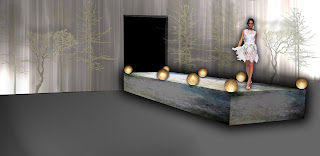Time and time again I must remind myself that design is not an individual effort. Even if it is not a group project, one must always design with the client in mind, as well as the community, builders, inspectors, and anyone else who may come in contact with the architecture. However in the beginning of this semester I was unaware of these parameters to the design process.
In the first iteration of Jenga 1.0, aside from communicating to Patrick and Claire about my design and following the guidelines of the project, I basically had free reign to do as I please. Being able to articulate my design voice into the assignment was the best part. There was no conflicting ideas or having to compromise on anything. Not that I would consider myself selfish in that matter but all designers want their identity to shine through. Another aspect of this project that I enjoyed was the fact that it taught us how to revaluate our way of thinking, developing concepts and understanding how we work independently. When asked at the start of the semester, ‘what my design process was? ‘ I hesitated and felt like a deer in the headlights. Honestly I didn’t know what my design process was, I ‘just’ did what was asked of me. Nonetheless, I used this confused state to answer a few questions in the next phases of the Jengas.
After a fast pace start to the semester we began catching our breathe and being able to sustain a comfortable speed in the next few assignments. Sometimes when leaping into things it takes a little effort to catch up with the tempo.
Following Jenga 1.0 was 2.0 where we had a chance to redeem our designs and up the bar. Again we were working individually but we could sense a group project in the air. Thus came the group project that most would fear but like a train it was full steam ahead for me. The first two projects were about finding our process and our design voice now it was time to have our voices woven together in one cohesive manner. I have always been the type of person that loved working in teams. All throughout my pre college years I had been on sports teams and involved with student government, so naturally I wanted to take the lead with this team.
Our team was one with distinctive facets (to say the least); we had difficulties in communication and time management. At times personal issues became a problem and the team was not connecting, but this was just the initial group project. Although there were contentions within the group they made for great lessons because as we discussed in class our profession will be dealing with teamwork forever and it is obligatory that we work together now, so we took a timeout to reconsider what was going wrong and mended the problems. We procured personal issues out of the equation for starters and then developed plans to work on our progression in the project and how we could communicate more efficiently to each other. The best part of our group was that we never had issues with whose design identity would show through. In that aspect everyone excelled and our end product was very consistent. However, that was not the case for Jenga 5.0 when we merged two groups together and became a group of six.
It’s never easy to be heard when you are drowning in a sea of squabbling voices. These occasions call for megaphones (theoretical that is). In this group of six it was never a personal issue as it was whose intentions were going to be more apparent than others. But what I learned wasn’t necessarily who could be the loudest that was going to make more decisions but it was the one who could hear all of the squabble, process it, and combine ideas to make both sides content. In the end that is exactly what happened. There are still issues at hand that need tending to but for the most part our group of six has become a team with one voice and we have discovered that design can live within the individual and within a large group.
In spite of some obstacles along the way, I have now made it through ¾ of the semester and have finally discovered the process in which I tackle a project, honed in on my areas of expertise, and found my design language. I have even learned how to appreciate the writing aspect of the course.




























